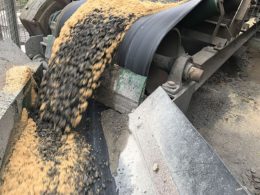
Incorrect practice in material discharge and the overall housekeeping of the belt may result in premature failing conveyor components, tracking issues, excessive belt wear and spillage – resulting in a decrease in productivity.
1. Accessibility to Location For Inspection
For any maintenance work to be completed on a belt cleaner the surrounding area must be completely isolated and hazard managed.
Primary belt cleaners are commonly installed in very adverse locations around the plant. Positions often include at the head pulley of an incline belt, further complicated by enclosed hoods or guards. In some mobile equipment cases there is sometimes no direct catwalk and staff are required to use a scissor lift, work platforms or actually lowering the conveyor to gain access. In other extreme cases, specialist training such as confined space access or working at heights must be undertaken in order to maintain the belt cleaners.
By maintaining the life of the belt cleaner, it will result in a reduction in the number of stoppages for maintenance tasks and improve overall site productivity.
2. Selection of the Best Wearing Material
There are several different materials used as cleaning blades; the most well known and favourable blades being made from polyurethane or tungsten tipped. Before selecting a blade type, you should consider the condition of your belt and your future belt preservation objectives.
Tungsten: Due to its higher BHN value, tungsten tipped blades on primary belt cleaners should not be installed on belts with mechanical fasteners, as the tungsten may destroy the join, unless it has been properly protected and purposely tailored to run with Tungsten tips.
Polyurethane: Due to its lower durometer, the blade is less likely to cause damage to a splice or belt in already poor condition and is the preferred medium when used on belts joined by mechanical fasteners and cold splices.
3. Installation Mounting
The incline of the conveyor needs to be considered when the cleaners are mounted. Failure to do so will result in the cleaner not correctly scraping the belt, resulting in sticky material collecting between the blade and the conveyor belt, causing inefficient cleaning and premature wear.
It is recommended that the belt cleaner be positioned below the horizontal line perpendicular to the pulley vertical line, not necessarily parallel to the stringers or conveyor belt. Material trajectory should also be taken into consideration.
4. Correct Sizing and Profiling
Experience has shown, that approximately 1 in 3 cases of premature wear on belt cleaners is caused by incorrect profiling of the cleaner against the conveyor belt. Over time, a wear pattern occurs, parabolic in appearance similar to a “smile”. This is due to the parts of the blade contacting the clean sections of the belt and not wearing in comparison to the centre, therefore restricting the rest of the blade from adjusting itself closer to the head drum. It is suggested that sections be cut off, where the smiling is starting to form, providing a more even cleaning edge.
5. Tension Adjustment
Previous studies have shown that over-tensioning of the cleaner increases frictional drag on the belt, decreasing the wear life of the cleaner whilst also increasing the overall power consumption of the conveyor. If fasteners have been added to the belt to fix tears, over-tensioning the belt cleaner may result in the cleaner being damaged or the fasteners being forcefully removed. Some belt cleaning systems have centralized torque transmitters, engineered to self-adjust and maintain an evenly distributed yet concentrated pressure on the centre of the belt, where the majority of the cleaning is required.
Conclusion
Correct belt cleaning should never be an overlooked element in conveyor maintenance. If a well engineered cleaner is installed correctly, considering these 5 factors, not only will the cleaner get optimum life but so will the other associated conveyor componentry, the valuable belt and structure of the conveyor itself. The role of maintenance is transformed from fixing breakdowns to optimizing overall productivity, placing the maintenance function at the heart of the quality improvement process.